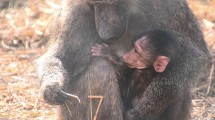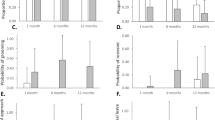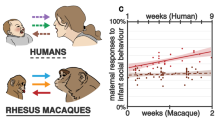Abstract
Left-cradling bias is a distinctive feature of maternal behaviour in humans and great apes, but its evolutionary origin remains unknown. In 11 species of marine and terrestrial mammal, we demonstrate consistent patterns of lateralization in mother–infant interactions, indicating right hemisphere dominance for social processing. In providing clear evidence that lateralized positioning is beneficial in mother–infant interactions, our results illustrate a significant impact of lateralization on individual fitness.
This is a preview of subscription content, access via your institution
Access options
Access Nature and 54 other Nature Portfolio journals
Get Nature+, our best-value online-access subscription
$29.99 / 30 days
cancel any time
Subscribe to this journal
Receive 12 digital issues and online access to articles
$119.00 per year
only $9.92 per issue
Buy this article
- Purchase on Springer Link
- Instant access to full article PDF
Prices may be subject to local taxes which are calculated during checkout


Similar content being viewed by others
References
Harris, L. J. Laterality 15, 56–135 (2010).
Pileggi, L. A., Malcolm-Smith, S. & Solms, M. Laterality 20, 154–170 (2015).
Sieratzki, J. S. & Woll, B. Lancet 347, 1746–1748 (1996).
Sieratzki, J. S. & Woll, B. Epidemiol. Psichiatr. Soc. 11, 170–176 (2002).
Brancucci, A., Lucci, G., Mazzatenta, A. & Tommasi, L. Phil. Trans. R. Soc. B 364, 895–914 (2009).
Todd, B. K. & Banerjee, R. Laterality 21, 12–33 (2016).
Fleva, E. & Khan, A. Laterality 20, 711–722 (2015).
Huggenberger, H. J., Suter, S. E., Reijnen, E. & Schachinger, H. Brain Cogn. 70, 67–72 (2009).
Bourne, V. J. & Todd, B. K. Dev. Sci. 7, 19–24 (2004).
Rosa Salva, O., Regolin, L., Mascalzoni, E. & Vallortigara, G. Comp. Cogn. Behav. Rev. 7, 110–138 (2012).
Lindell, A. K. Front. Hum. Neurosci. 7, 464 (2013).
Scola, C., Arciszewski, T., Measelle, J. & Vauclair, J. Eur. J. Dev. Psychol. 10, 707–722 (2013).
Vallortigara, G., Rogers, L. J. & Bisazza, A. Brain. Res. Rev. 30, 164–175 (1999).
Altmann, J. Behaviour 49, 227–266 (1974).
Forrester, G. S., Crawley, M. & Palmer, C. Brain Cogn. 91, 21–27 (2014).
Quaresmini, C., Forrester G. S., Spiezio, C. & Vallortigara, G. J. Comp. Psych. 128, 276–284 (2014).
Baraud, I., Buytet, B., Bec, P. & Blois-Heulin, C. Behav. Brain Res. 198, 449–458 (2009).
Nagy, M., Akos, Z., Biro, D. & Vicsek, T. Nature 464, 890–893 (2010).
Rogers, L. J., Vallortigara, G. & Andrew, R. J. Divided Brains: the Biology and Behavior of Brain Asymmetries (Cambridge Univ. Press, 2013).
MacNeilage, P. F., Rogers, L. J. & Vallortigara, G. Sci. Am. 301, 60–67 (2009).
Hoffman, A. M., Robakiewicz, P. E., Tuttle, E. M. & Rogers, L. J. Laterality 11, 110–121 (2006).
Thiebaut de Schotten, M. et al. Nat. Neurosci. 14, 1245–1246 (2011).
Waring, G. H. Horse Behavior 2nd edn (Noyes Publications/William Andrew, 2003).
Karenina, K. et al. PLoS ONE 5, e13787 (2010).
Karenina, K., Giljov, A., Ivkovich, T., Burdin, A. & Malashichev, Y. Orcinus orca . Anim. Behav. 86, 1225–1231 (2013).
Manning, J. T., Heaton, R. & Chamberlain, A. T. J. Human Evol. 26, 77–83 (1994).
Ghirlanda, S. & Vallortigara, G. Proc. R. Soc. Lond. B 271, 853–858 (2004).
Karenina, K., Giljov, A., Glazov, D. & Malashichev, Y. Behav. Ecol. Sociobiol. 67, 1195–1204 (2013).
Phillips, C. J. C., Oevermans, H., Syrett, K. L., Jespersen, A. Y. & Pearce, G. P. J. Dairy Sci. 98, 2389–2400 (2015).
Versace, E., Morgante, M., Pulina, G. & Vallortigara, G. Behav. Brain Res. 184, 72–80 (2007).
Acknowledgements
We thank the administration of the protected areas where data were collected for their cooperation and support. We thank A. Smorkatcheva, A. Vashurkina, V. Kalmikov, A. Kochnev, K. Leggett and S. Nicol for help in the organization of the field studies. The collection of data on lateralization in Pacific walrus, Siberian tundra reindeer, argali and southern right whales (inspection of aerial photographs), and all analytical work, was funded by the Russian Science Foundation (grant no. 14-14-00284). Field studies on grey and red kangaroos were supported by the National Geographic Society Committee for Research and Exploration (grant no. 9261-13). Field studies on saiga antelope, muskox and feral horses were supported by the Russian Foundation for Basic Research (grant no. 14-04-31390), and Saint Petersburg University (grant no.1.42.508.2013). The data on southern right whales were provided by Ocean Alliance and the Instituto de Conservacion de Ballenas, and were collected under research permits from the Dirección de Fauna y Flora Silvestre and the Subsecretaría de Turismo y Áreas Protegidas of Chubut Province, Argentina. Work was conducted with the approval of each protected area’s authorities and St Petersburg State University ethical committee (permit no. 131-03-5).
Author information
Authors and Affiliations
Contributions
K.K. and A.G. designed the study, organized the expeditions, performed data collection and analyses, and wrote the paper. J.I. helped to organize the field work and to collect data on grey kangaroos, and contributed to and edited the paper. V.R. performed the individual identification of southern right whales and edited the paper. Y.M. supervised the project, collected data, and contributed to and edited the paper.
Corresponding authors
Ethics declarations
Competing interests
The authors declare no competing financial interests.
Supplementary information
Supplementary information
Supplementary Methods, Supplementary Figures 1–4, Supplementary Tables 1–3, Supplemenetary References (PDF 1240 kb)
Supplementary Tables
Supplementary Tables 4–14 (XLS 91 kb)
Rights and permissions
About this article
Cite this article
Karenina, K., Giljov, A., Ingram, J. et al. Lateralization of mother–infant interactions in a diverse range of mammal species. Nat Ecol Evol 1, 0030 (2017). https://doi.org/10.1038/s41559-016-0030
Received:
Accepted:
Published:
DOI: https://doi.org/10.1038/s41559-016-0030
This article is cited by
-
Fish self-awareness: limits of current knowledge and theoretical expectations
Animal Cognition (2022)
-
The Influence of Target Animacy and Social Rank on Hand Preference in Barbary Macaques (Macaca sylvanus)
International Journal of Primatology (2021)
-
Lateralization of social signal brain processing correlates with the degree of social integration in a songbird
Scientific Reports (2020)
-
Human-like maternal left-cradling bias in monkeys is altered by social pressure
Scientific Reports (2020)
-
Individual, but not population asymmetries, are modulated by social environment and genotype in Drosophila melanogaster
Scientific Reports (2020)



